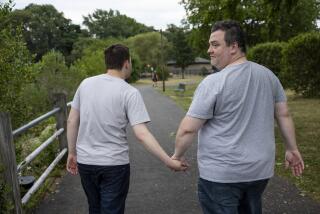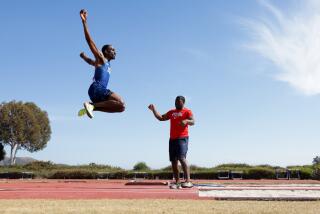Horseback Riding Program Puts the Disabled in Saddle : Therapy: Organization gives physically and developmentally challenged individuals a chance to grow. About 50 volunteers teach more than 70 students each week.
Sourena Vasseghi slowly leaves the arena and prepares to dismount in the shadow of a stone barn.
âTake your time,â says his coach. Carefully, Sourenaâs palsied leg is lifted over his horseâs head, and he slides down the side of his mount into his fatherâs waiting hands.
Sourena, who is 13, stands still a moment, gathering his balance. âWatch this!â he shouts to his audience of volunteers, parents and other riders. With a voice as thick as oatmeal, the boy, who has cerebral palsy, orders his father to âlet go!â
Lurching forward, he takes five or six steps, teetering from side to side, and lands in his fatherâs outstretched arms. The watchful crowd erupts in applause. Shouts of joy bounce off huge oak trees and echo across the ranch, while tears flow as freely as a champagne fountain.
âIâve been practicing,â Sourena announces.
Someone asks, âIs this the first time youâve ever walked on your own?â
âYes,â he says, beaming. âAnd I will practice, and be able to do it better and better.â
Nora Fischbach, Sourenaâs coach, is the program director of Special Equestrian Riding Therapy, in the picturesque hills surrounding Agoura. Fischbach, a special education tutor and an avid horsewoman, also has extensive training in therapeutic riding.
âInitially, our original members were part of the Special Olympics equine therapy program,â she says. âSERT evolved, in 1987, out of the desire not to limit a program just to the mentally retarded. Our goal is to provide an opportunity for physically and developmentally challenged individuals to achieve emotional and physical growth through horsemanship.â
Barbara Roessler, one of the organizationâs founders----she was formerly a vice president and board member--chairs the fund raising. Roessler, after dedicating many years to the therapeutic riding group, eloquently expresses what it means to its participants.
âIt is a long way up to the back of a horse from a wheelchair,â says Roessler, âor for a sightless person unable to judge space and distance; or for a retarded individual; or for an autistic, or even a learning-disabled child who has difficulty focusing on a task and comprehending instructions. The athletes strive to rebuild their bodies and minds, but they also radically alter societyâs preconceptions of the disabled.â
Accredited by the North American Handicapped Riding Assn. (NAHRA), the group has received the associationâs highest rating. Though the organization is large, with about 50 volunteers teaching more than 70 people each week, it is only one of 206 such groups in the United States and Canada. There are 90 groups in the Southwest alone.
Equestrian therapy organizations in the area include Ahead With Horses, Heads-Up and the Institute of Equestrian Therapy. These associations share Special Equestrian Riding Therapyâs dedication to improving the quality of life for the disabled.
Dr. Michelle Larson, an assistant professor in pediatric research at USC who has seen firsthand the positive effects of horseback riding for the disabled, has proposed a study that would scientifically document the value of it.
âI have been involved with kids who have participated in programs such as SERT and I have seen the benefits of therapeutic riding,â Larson says.
âFor instance, in children with cerebral palsy, there is definitely a reduction in the extreme muscle tone that causes their muscular spasms. That reduction then allows them to use their muscles correctly and improves balance and posture while also increasing strength.
âFor other children who need to gain muscle tone, the bopping up-and-down motion on a horse helps to build muscle. Hand and eye coordination improve, too.â
Larson believes that such therapy can be used for a variety of disabilities. âAnd because it elevates self-esteem, it certainly builds feelings of control. Overall, therapeutic riding can lead to improved functioning of a child. The details of how it happens is what I plan to document.â
Riding coaches devise various teaching methods.
âGames such as horse basketball keep motivation strong,â Fischbach explains, âbecause the kids view it as fun and not painful physical therapy. But each time they complete an obstacle course or have to lean off their horse at a 45-degree angle to reach for a flag in a relay race, and then recover their balance, they are learning coordination, in addition to improving memory and order.
âThe games also teach concepts and skills that are a problem for the developmentally disabled,â she says. âThrough this game strategy, athletes learn colors, shapes, sizes, left, right, up and down, while the desire to communicate is increased by the kids cheering each other, and that encourages speech in nonverbal and autistic individuals.â
After Sourena rode the first time, he was so discouraged that he wanted to give up, says the boyâs father, Ben Vasseghi. âBut I sensed that Sourena would benefit greatly. . . . I watched the way he was able to sit, his position on the horse, and how he spread his knees, which had always been too tight from spasms. I guess it was that, and the fact that Sourena has never finished anything, which made me insist he try again.â
Sourena tried again, and again and again, progressing from sitting with another rider behind him to sitting alone on his horse.
Sourena had been riding for only about five weeks when he took those first independent steps.
âNow,â says his father, âSourena knows he can do it; he walks better, talks better, is more positive and willing to try, and stick with new things. He even talks about giving away his wheelchair.â
Not all the parents recognized the programâs value, at first.
Bunny Pearlman admits that she was afraid to have her son Larry, 35, participate.
âI was afraid it was another place he would fail. However, I had reached a point in my life, and his, when I had to let him explore and go on his own, let him find out the truth about himself. The truth was beautiful,â she says.
Though Pearlman has stayed away whenever Larry has ridden, to prevent transmitting her anxieties, she was at a horse show for the disabled when Larry, who was born with brain damage and is blind, won a first-place trophy.
âLarry hasnât always been a winner, but SERT has made a powerful difference in his life,â his mother says.
For Michael Bluechel, an autistic 6-year-old, â âGo ride a horse Saturday,â has become his mantra,â says his mother, Carol Bluechel. âHe stays calm because he knows no matter what else happens, Saturday will come.â
The coaches and volunteers in the SERT program are quick to say it has affected their own lives, too.
Fischbach, who says SERT came into her life when her self-esteem was low and she lacked direction, maintains: âI discovered you donât find direction looking inward; you find it looking outward. How could I complain, when these individuals, against all odds, worked so hard to exceed their limitations?â
Volunteer Bill Bumiller, an actor, says, âWorking with these kids . . . is a giving situation, an opportunity to do for someone else, as opposed to working in a profession that can be so self-consuming.â
He adds, âThere is a strong sense of family around here. I am personally involved in the lives of these children and their parents; and they are in mine.â
Two other volunteers whose lives were changed by their volunteer work with the organization are Phil Batwin and Beth-El Klein.
In September, 1990, they met at the Stone Barn ranch. And on May 5, 1991, they were married at the ranch.


